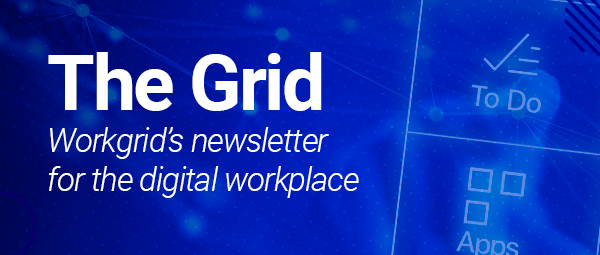The evolution of employee experience
I was a guest on a recent podcast episode with The Digital Workplace and I was asked, among other things, about how employee experience has changed in recent years. The simplest answer is that it’s become more complex. It’s had to be. Most organizations are still working remotely, and for those that have begun to make their way back to physical offices, it’s often in a hybrid capacity, with a mix of office and remote.
![[asset] Fortune-where-workers-prefer-to-work](https://images.ctfassets.net/z7p73u8c0thn/wkEF1xJAQuvET2PDPVIJX/ca062b0ae9e6365e8a1c305f4aa06341/L70aU-where-u-s-workers-prefer-to-work.png?w=1200&h=478&q=60&fm=png&bg=transparent)
A startlingly low number of remote workers want to go back to their office routine after the pandemic (Source)
Physical offices will likely never again be the dominant work experience, putting the digital workplace in the spotlight.
So what does that mean for the nature of work? Managing lots of change and making some pretty big mind shifts…
Managing noise and friction in the digital workplace
As digital transformation efforts have accelerated over the past year and a half, organizations have focused on delivering the applications employees need to work successfully outside the office. This rapid deployment of ad-hoc apps has been successful, but it has also created a patchwork of end-user technology that’s frustrating for employees to interact with. Their digital experience is fragmented, fraught with noise that impedes their productivity.
![[asset] Digital Workplace Complexity](https://images.ctfassets.net/z7p73u8c0thn/6UVW4oFmc245yLsET8ScPA/15ad6437523aafe697cbd24618f95f1b/Complexity.jpg?w=1200&h=968&fl=progressive&q=60&fm=jpg&bg=transparent)
Managing noise and friction in the digital workplace is a serious impediment to productivity and the employee experience.
This isn’t how technology is supposed to work. It’s supposed to make our lives easier, not create more friction in the work day.
Unfortunately, this problem is only going to get worse. Companies that have historically invested in large ERP systems as the “one system to rule them all,” expecting them to fulfill a variety of purposes across the organization, are changing their tactic. Instead of using monolithic systems designed to meet the needs of administrators and power users, they’re making the switch to using an array of pointed solutions designed to meet the specialized needs of their workforce.
While that approach will certainly do a better job at meeting certain needs of everyday users, it will result in creating a splintered experience. To address this issue, there will need to be an increased focus on creating simpler, more unified experiences. This can be accomplished by abstracting just the tasks and information employees need from across the technology sprawl and presenting it in a single, personalized, and contextual experience.
![[gif] workgrid-functionality](http://images.ctfassets.net/z7p73u8c0thn/38BtHgXbdurZboeVLcyZmr/bb062bae3b111e94f06374f8b156207a/Workgrid_Functionality.gif)
It will also be necessary to consider the different digital engagement channels employees use, which are dependent on each employee’s persona. Consider the journeys and moments of truth that influence the digital experience of an employee who works in a field-based service role. It’s completely different than the experience of a desk worker or someone on the manufacturing floor. To optimize productivity and ensure maximum adoption and use of technology, those differences need to be given thoughtful consideration.
Improving productivity in the digital age
Managing friction isn’t the only necessary evolution taking place in the digital workplace. The ways in productivity is fostered is also adapting.
It’s an increasing reality that whether organizations return to the office, stay remote, or opt for a hybrid approach, the physical workplace is being deprioritized. It’s no longer the central location where employees work and collaborate. Instead, the digital workplace now bears the burden of enabling employees to be productive wherever and whenever it’s convenient for them.
That’s a tall order, especially given the challenges discussed above regarding digital friction and noise.
![[asset] stopwatch-stock-photo](https://images.ctfassets.net/z7p73u8c0thn/3Zz4uuXS7MCQMrLMXQpDmc/03a7dd746b8f2b47315f956f8843c7ce/stopwatch-ge2504e10d_1920.jpg?w=1200&h=800&fl=progressive&q=60&fm=jpg&bg=transparent)
Productivity is best measured by how much time employees have to focus on what they were hired to do.
It can be done, but for the digital workplace to be successful in driving productivity, technology will have to play an entirely different role than it ever has before. More is no longer better - in fact, it has the opposite effect. For optimum productivity results, technology should:
Simplify tasks and make information easy to find
Deliver personalized experiences by persona
Be understood by employees with easy-to-use, intuitive interfaces
Leverage automation or AI to automate tasks and help employees be more efficient
Addressing the holistic needs of employees
Reducing friction and improving productivity in the digital workplace are all a part of the new trend of managing the holistic needs of employees. Recognizing that when employees’ higher-level needs are met regarding fulfillment, engagement, etc., they will bring their best selves to their work.
It’s a movement that’s long overdue. Studies show that employees are most engaged when they’re focusing on high-value work. Unfortunately, the ability to do that is hampered by the fact that a significant part of their day requires them to fulfill the basic duties of being an employee – completing required paperwork, submitting requests, etc. That time, spent completing mundane, repetitive, multi-step tasks, takes valuable time away from the meaningful work that drives business value.
So how can that be improved? By focusing on how to efficiently accomplish the intent of those routine tasks.
Consider the example of taking a day off. It seems like a simple, straight forward task, but when you take a close look, it really isn’t. In most organizations, workers have to access an HR system to log time, a project management system to update availability or time on task, a finance system to log unbillable hours, an email system to set out of office notification, and more.
Not only is this process time-consuming because of the number of steps involved, it’s also mentally draining, requiring employees to know how to access each of the systems they need, log-in (in the absence of single sign-on), and have the required institutional knowledge to navigate each application.
![[blog image] vacation-request-systems-example](https://images.ctfassets.net/z7p73u8c0thn/45ljY7ZJ2AEbQqKSg2ypIM/ba92d8dfcf8061e87b7c3e94910f786c/Vacation2__1_.jpg?w=1200&h=654&fl=progressive&q=60&fm=jpg&bg=transparent)
Workgrid focuses on helping employees quickly and easily fulfill their intent, reducing complex processes down to just a few clicks.
We need to rethink these processes from start to finish and consider them from the perspective of the end user, especially since employees have come to have such high expectations of the digital experiences they encounter. How can technology be used to help employees accomplish their intents more quickly, without the complexity of technology getting in the way?
Thankfully, organizations are beginning to turn this around now, making the shift to viewing the digital employee experience as they view the digital customer experience:
Taking a design thinking mind-set rather than a systematic one
Focusing on ease of use and simplifying experiences
Designing digital interactions using outcome-driven design, taking employee intent into consideration so that the unnecessary complexity of behind-the-scenes technology is eliminated
Addressing the emotional wellness of employees in the digital workplace is also becoming a greater focus, with the increase of hybrid and remote work making it more difficult to sustain employee interactions and human connections in a completely digital world.
The inability of employees to connect face-to-face has had a big impact on employees’ sense of belonging. The lack of impromptu “water cooler” chats or being able to simply wheel over to a coworker’s desk to talk has left a void in the social and emotional lives of employees. And while events like virtual happy hours, pet shows, etc., are effective on some level, they only address part of the problem. The bigger issues of mentorship, relationship building, and so on, will have to be re-imagined if engagement is going to be maintained over the long-term.
![[asset] employee-meeting-stock-photo](https://images.ctfassets.net/z7p73u8c0thn/1xknz5S8litLQArv0kWwmG/20a01b59e5a948db59213b8d9c80c3fd/christina-wocintechchat-com-LQ1t-8Ms5PY-unsplash.jpg?w=1200&h=800&fl=progressive&q=60&fm=jpg&bg=transparent)
Finding ways to help employees connect meaningfully is one of the biggest challenges presented with a distributed workforce.
The role of citizen developers in the digital workplace
Finding ways to help employees connect meaningfully is one of the biggest challenges presented with a distributed workforce.
There's a shortage of skilled workers to keep up with demand (by 2030, the global talent shortage is expected to reach 85.2 million.)
Organizations are struggling under technical debt, with a heavy reliance on legacy systems
Poor data quality and data silos are creating further issues, such as reduced worker productivity
Change management and the culture to shift needs for the future is also a challenge:
The tools we’ve used in the past are simply not going to continue to meet the needs of the future. To move at the speed of modern-day business, it will be critical to open the innovation funnel, achieving faster time-to-value, fostering higher levels of innovation without IT dependency, and establishing clear governance to remove risk.
Citizen developers are the key to overcoming these challenges because they can build experiences more quickly than traditional methods, using no-code technology that leverages visual interfaces rather than coding. They are also closer to the needs of the business and have a better understanding of which kinds of applications would be most useful.
![[asset] workgrid-no-code-example](https://images.ctfassets.net/z7p73u8c0thn/2OACUD3W567vONjrell8yX/d7df79f2d7ec87febe5a3193193ebaf5/Workshop_image.jpg?w=1200&h=392&fl=progressive&q=60&fm=jpg&bg=transparent)
There is confusion though about what low-code/no-code development is, and that can stand in the way of organizations leveraging it to its fullest potential. The biggest thing to understand is that, in the end, it’s all code.
Traditional developers will still be needed to handle programming requirements (security, scalability, platform availability, etc.). They’ll just be less focused on individual app development, spending more of their time developing the platform capabilities that support the enablement of citizen development.
Preparing for the future of work
The world of work is unrecognizable from what it was even just a few years ago. That's going to mean a lot of change, a sentiment that's echoes by thought leaders across the industry:
![[asset] jacob-morgan-quote](https://images.ctfassets.net/z7p73u8c0thn/2tRJw2IjL836KAQqCAfqTP/b46e598ed70429da1d210b8ddc88362c/JacobMorgan_Quote.png?w=780&h=200&q=60&fm=png&bg=transparent)
Change can seem daunting, but it also provides tremendous opportunity for organizations willing to adapt. Now is the time to take advantage of it.
Check out my full comments in the podcast "Reducing the noise of the digital employee experience.”

![[asset] citizen-developers-stats](https://images.ctfassets.net/z7p73u8c0thn/2e5nSgp7dfeL8Gi9AiLBsF/1603e8416717285e9f3475038561e8c0/Boxes.png?w=1200&h=375&q=60&fm=png&bg=transparent)



